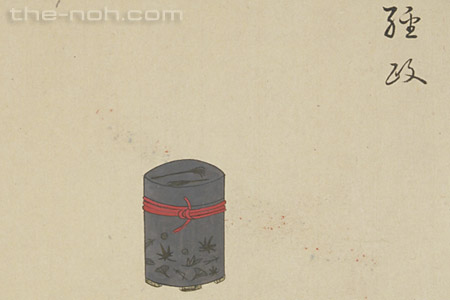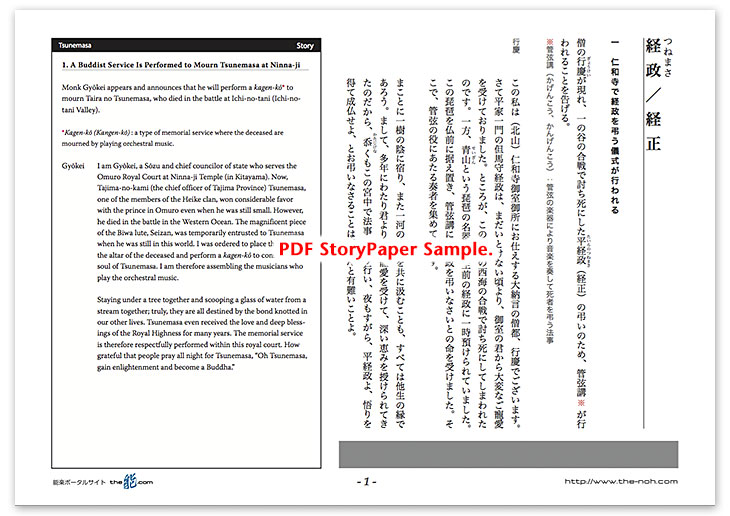
 Tsunemasa
Tsunemasa

![]()
Sōzu Gyōkei, a monk serving in the Omuro Royal Court in Ninna-ji Temple in Kyoto, was ordered by a prince who renounced the world to pray for Taira no Tsunemasa who died in the battle at Ichi-no-tani (Ichi-no-tani Valley). Tsunemasa, who was a renowned lute player, used a Biwa lute named Seizan regularly. Gyōkei therefore offers the instrument before the altar of the deceased and performs a service with music (kagen-kō*).
The music to pray for Tsunemasa becoming a Buddha is resonating and when the night grows old, a shadow of a person starts to appear faintly in the lamplight. Gyōkei, who is mystified, asks who he is, and the shadow answers that he is the ghost of Tsunemasa and appeared to appreciate the Buddhist prayer.
When Gyōkei faces the voice, the shadow disappears like filament of air and only his voice is left. As Gyōkei exchanges words with the voice, the ghost misses his old days when he appreciated the natural beauty of flowers, birds, wind, and the moon and enjoyed poems and music. He then plays the lute Seizan and dances to recall his past and enjoys the nightlife. However, the fun moment does not last long. He, who fell into the Realm of Asura, starts to feel resentment. Tsunemasa shows himself suffering from wretched fights and extinguishes the light because he does not want others to see him acting such shameful deeds. The ghost disappears faintly into the darkness.
*Kagen-kō (Kangen-kō): a type of memorial service where the deceased are mourned by playing orchestral music.
![]()
The protagonist of this piece is Taira no Tsunemasa, the eldest son of Taira no Tsunemori and a nephew of Taira no Kiyomori, who led the Heike clan. He is also a brother of Taira no Atsumori, who is also a protagonist of the Noh drama called Atsumori. Among the members of the Heike clan who indulged themselves in aristocratic pleasures, Tsunemasa especially gained a reputation as a skillful player of the Biwa lute and was an outstandingly talented man.
With such a cultural background, this piece does not exude a bold atmosphere although it is classified as a shura-mono (the stories about warriors who descended to the Realm of Asura). It elegantly describes Tsunemasa who misses his days when he enjoyed reading poems and playing music in this world. The whole drama embraces a graceful atmosphere of the noble culture in the Heian period. Although the last part of the drama describes some scenes of fighting, Tsunemasa even feels ashamed of being witnessed him fighting a battle and puts the light out. This is a sophisticated short piece, which emphasizes the gracefulness and elegance of a young noble. The kuse where Tsunemasa misses his living days and enjoys the sound of a Biwa lute is accompanied by a dynamic chorus and dance, which is an especially interesting part in this piece. Throughout the drama the audience, including the Noh novice, can casually enjoy the good tempo of this piece.
Probably because of the airy and light atmosphere of the drama, many young Noh performers perform this piece. It is also popular for amateur Noh performers who play the shite (protagonist) for the first time in his/her life. Also, some schools add special staging features to enhance the graceful atmosphere of this piece.
Traditionally, princes became the priest of Ninna-ji Temple, where the story takes place, after they renounced the world. The temple is therefore also called the Omuro Royal Court. This temple, with its long and distinguished history, is registered as a World Cultural Heritage.
STORY PAPER : Tsunemasa
Story Paper presents noh chant stories in modern speech, with story outlines, highlights and more using Adobe PDF format, which can print out and zoom in. Print out the pages and take them with you when you see the actual noh performance.

The copyright of Story Paper is held by the Noh.com. Story Paper is for individual use only. It is prohibited by the copyright law to distribute or publish printed-out Story Paper pages without prior consent. For more information, check the credit and disclaimer pages.



 [Tsunemasa : Story Paper PDF : 435KB
[Tsunemasa : Story Paper PDF : 435KB